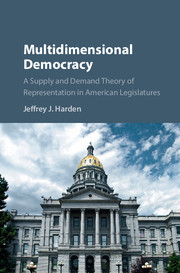Book contents
- Frontmatter
- Dedication
- Contents
- List of Figures
- List of Tables
- Acknowledgments
- 1 Responsiveness Beyond Roll Calls
- 2 A Supply and Demand Theory of Representation
- 3 Citizen Demand for the Dimensions of Representation
- 4 The Determinants of Legislators' Representational Priorities
- 5 Legislative Websites and the Dimensions of Representation
- 6 Unifying the Dimensions of Representation
- Appendix A Appendix to Chapter 3
- Appendix B Appendix to Chapter 4
- Appendix C Appendix to Chapter 5
- References
- Index
2 - A Supply and Demand Theory of Representation
Published online by Cambridge University Press: 05 November 2015
- Frontmatter
- Dedication
- Contents
- List of Figures
- List of Tables
- Acknowledgments
- 1 Responsiveness Beyond Roll Calls
- 2 A Supply and Demand Theory of Representation
- 3 Citizen Demand for the Dimensions of Representation
- 4 The Determinants of Legislators' Representational Priorities
- 5 Legislative Websites and the Dimensions of Representation
- 6 Unifying the Dimensions of Representation
- Appendix A Appendix to Chapter 3
- Appendix B Appendix to Chapter 4
- Appendix C Appendix to Chapter 5
- References
- Index
Summary
Crisanta Duran represents Colorado House District 5, which encompasses northwest and central Denver. Her constituency is quite diverse in several respects, including considerable variation in income and race. Her goal as a legislator is to maximize communication with the public and “bring people into the political process.” Because of the many different perspectives in her district, she does that in many different ways.
Areas included in Rep. Duran's district range from the Sun Valley neighborhood, where 72 percent of the residents live in poverty, to downtown Denver, where many live in expensive high-rise condos. She says that the expectations that constituents from these areas have of her are often very different. For example, in response to demand from her downtown constituents, she has worked to extend tax credits for electric and fuel-efficient vehicles and to require homeowners’ associations to provide electric car charging stations. Among other things, constituents in the low-income neighborhoods of her district contact her for help with foreclosures or environmental problems that arise from nearby commercial and industrial areas.
Rep. Duran's website, which is available in both English and Spanish, reflects her responsiveness to this diverse group of constituents. Items on the site include details on her efforts to encourage access to renewable energy as well as $4 million in funding she worked to secure for renovation to the Auraria Campus Library. She also discusses efforts ranging from balancing the state budget to supporting driver's licenses for all Coloradans, including undocumented persons. In short, the job is not “one size fits all” for Rep. Duran. Instead, responding to her diverse constituency requires her to focus on several different dimensions of representation at once.
The democratic process implies that citizens should be able to get what they want from government by electing who they want. This is sometimes – though not always – the case with policy issues; research shows that there are electoral consequences for being out-of-step (Canes-Wrone et al., 2002; Hogan, 2008; Birkhead, 2015). However, representation in practice is based on more than just policy. Constituents’ preferences may be more complex, with some interested in representation through other means besides just policy. Similarly, legislators may choose to focus on those other means of providing representation. In this chapter, I develop a theoretical framework for conceptualizing the dimensions of representation as commodities that are both demanded by constituents and, in response, supplied by legislators.
- Type
- Chapter
- Information
- Multidimensional DemocracyA Supply and Demand Theory of Representation in American Legislatures, pp. 19 - 49Publisher: Cambridge University PressPrint publication year: 2015

